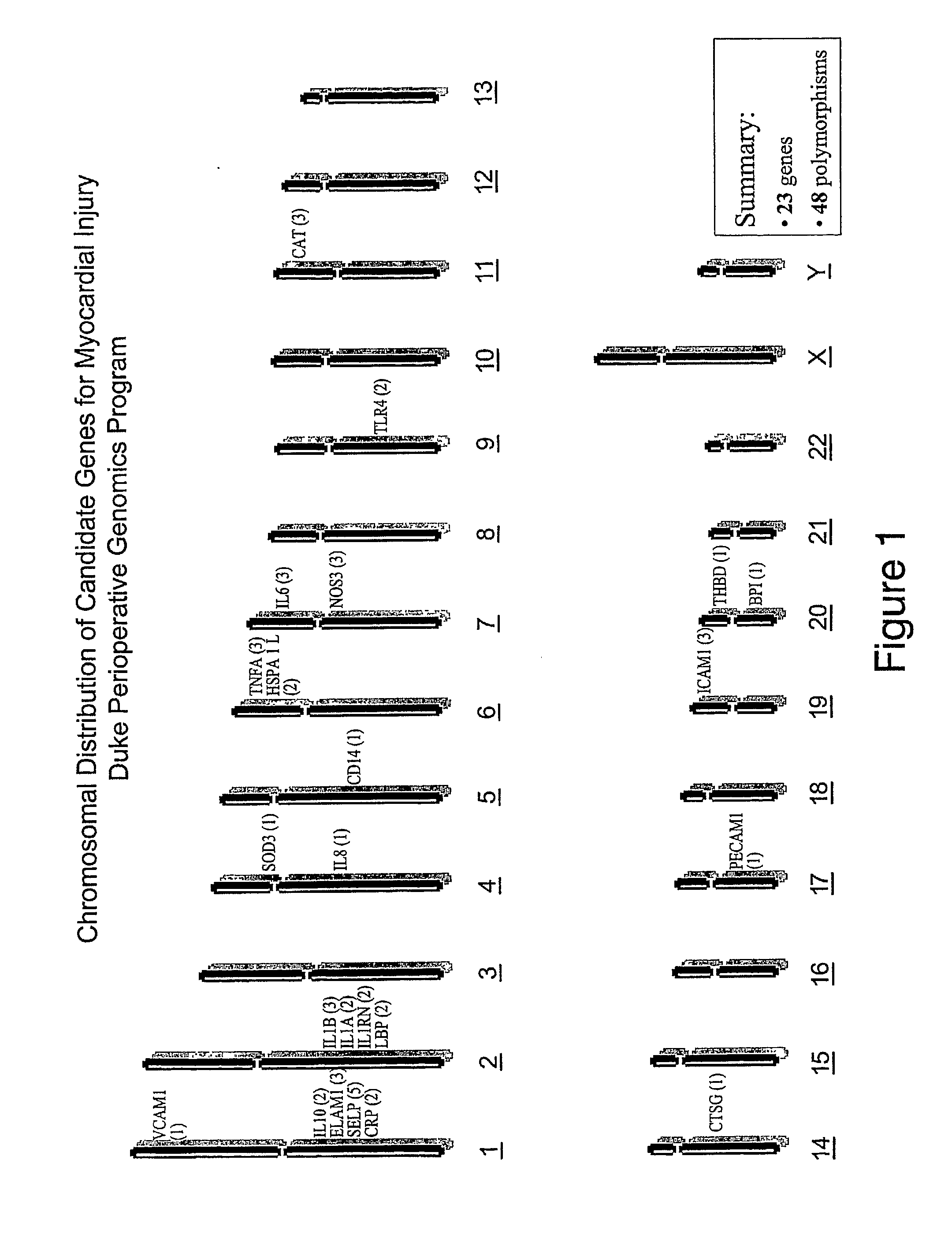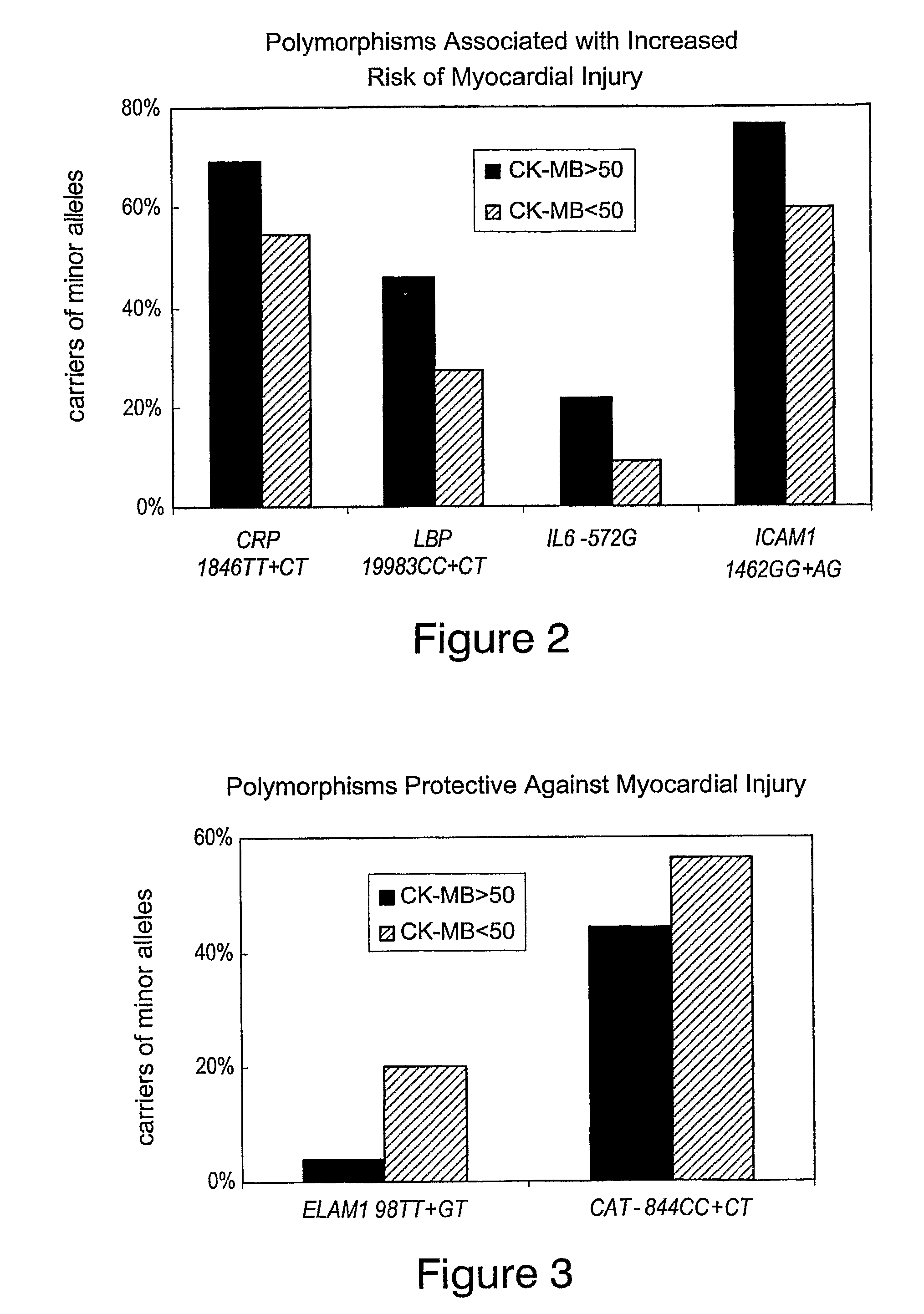Method of identifying individuals at risk of perioperative myocardial injury, major adverse cardiac events, cognitive decline, arrhythmias, depression or bleeding
a myocardial injury and perioperative technology, applied in biochemistry, biochemical equipment and processes, sugar derivatives, etc., can solve the problems of poor outcome risk for women, limited study scope, and multivariate analysis studies still showing worse survival for women up to 2-3 years, so as to improve neuroticism and improve the effect of mood
- Summary
- Abstract
- Description
- Claims
- Application Information
AI Technical Summary
Benefits of technology
Problems solved by technology
Method used
Image
Examples
example 1
Experimental Details
[0086]Study Population
[0087]The patients enrolled in this study were part of the Perioperative Genetics and Safety Outcomes Study (PEGASUS), an ongoing Institutional Review Board approved, prospective, longitudinal study at Duke University Medical Center. The current substudy targets a cohort of patients undergoing elective cardiac surgery utilizing cardiopulmonary bypass (CPB), during a specified period, in whom serial postoperative serum markers of myocardial injury were measured. Patients were excluded if they had a history of symptomatic cerebrovascular disease, renal failure, active liver disease, or bleeding disorders.
[0088]Patient Management
[0089]Anesthesia was induced and maintained with midazolam, fentanyl, and isoflurane with muscle relaxation provided by pancuronium. All patients underwent nonpulsatile hypothermic (30°-32° C.) cardiopulmonary bypass. The perfusion apparatus consisted of the Cobe CML membrane oxygenator™ (COBE Chem Labs, Lakewood, Colo....
example 2
Experimental Details
Study Design and Population:
[0106]Prospective cohort study of 434 patients (371 white, 63 non-white) undergoing cardiac surgery with CPB.
Phenotype Definition:
[0107]Serial determinations of serum creatine kinase-MB isoenzyme (CK-MB) mass levels were performed using an immunometric (sandwich) assay (Biosite Diagnostics, San Diego, Calif.) with an upper limit of normal of 5 ng / ml. Postoperative myocardial injury defined as a CK-MB level ≧50 ng / ml (i.e. 10 times upper limit of normal for the reference laboratory) at 24 hours postoperatively (Newby et al, Am. J. Cardiol. 144:957 (2002)). Patients with abnormal baseline CK-MK levels were excluded.
Selection of Candidate Gene Polymorphisms:
[0108]23 candidate genes involved in the pathogenesis of inflammation and myocardial ischemia / reperfusion injury were selected a priori based on previous transcription profiling in animals models, pathway analysis, a review of linkage and association studies reported in the literature,...
example 3
Experimental Details
Patient Sample:
[0115]Patients undergoing CABG surgery with cardiopulmonary bypass (CPB) with genotype data were included in the analysis sample. Patients were stratified into two subgroups based on the type of surgery performed: isolated CABG or CABG with any type of valve surgery.
Definition of Endpoint:
[0116]A composite endpoint, major adverse cardiac event (MACE), was defined for each patient. Relevant events included death, MI, repeat CABG, repeat revascularization, or cardiac arrest. For each patient, time (number of days) to the first of these events to occur following surgery was considered as the outcome in a survival analysis.
[0117]17 candidate gene polymorphisms were selected for analysis based on published associations with cardiovascular outcomes (Table 5). Polymorphisms were examined for both main effects and gender interaction associations with MACE. SNPs were characterized in three ways for the purposes of statistical analysis: ...
PUM
| Property | Measurement | Unit |
|---|---|---|
| partial pressures | aaaaa | aaaaa |
| partial pressures | aaaaa | aaaaa |
| emission wavelength | aaaaa | aaaaa |
Abstract
Description
Claims
Application Information
 Login to View More
Login to View More - R&D
- Intellectual Property
- Life Sciences
- Materials
- Tech Scout
- Unparalleled Data Quality
- Higher Quality Content
- 60% Fewer Hallucinations
Browse by: Latest US Patents, China's latest patents, Technical Efficacy Thesaurus, Application Domain, Technology Topic, Popular Technical Reports.
© 2025 PatSnap. All rights reserved.Legal|Privacy policy|Modern Slavery Act Transparency Statement|Sitemap|About US| Contact US: help@patsnap.com



